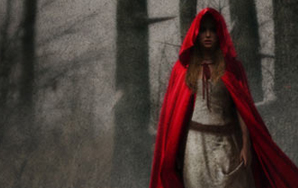Thoughts on the Red Riding Hood Trailer
Some faith is to be had; Hardwicke’s film Thirteen was a far cry heavier than the Twilight franchise, and she is not a stranger to the delicate and brutal inner workings of teenage girls. Because it is this percentage of the youth population who will flock to this film, it is a chance to reveal…

As the words “From the director of TWILIGHT” appeared on the screen, the theater full of Harry Potter fans erupted in titters. Despite the attractive lead actors and starkly stylistic cinematography of the trailer for upcoming attraction Red Riding Hood, it appeared that few were convinced of director Catherine Hardwicke’s attempt at an edgy adaptation of the fairy tale by the same name.
For a fable and folklore junkie like me – whose love for the genre extends far past Disney and further into the realm of retellings by Francesca Lia Block, Robin McKinley, and Gregory McGuire – I suppressed both my excitement and judgment. I enjoy the comeback of fairy tales and mythology in the worlds of cinema and literature (and popular music – although one may question Taylor Swift’s true knowledge of the term “fairy tale.”) At first glance, the image of the lovely hooded girl (played by Amanda Seyfried), awash in clouds of white and red, embedded itself directly to the romantic part of my soul that seeks archetypal visions. The other half of my
soul, the part that thrives on depth and theoretical analysis and was much molded by my background as an English major, immediately sought an allegory.
After all, the original purpose of fairy tales, as far back as ancient Egypt, was to frighten and educate children about the perils of the world. Western tales, primarily those such as “Little Red Riding Hood,” were directed almost entirely at young girls to prevent them from indulging in the dangers and thrills of sexuality. To an even marginally perceptive reader, the colors in the tale represent much of the subtleties – the red hood of the young protagonist not only symbolizes, in several ways, her virginity, but also the standards of oppression under which she is held. The path on which she is to embark is a pre-paved rode of her life’s journey. The wolf, like any beast, functions as a seductive creature whose desires stir in syncopation with hers. Her demise occurs when she falls victim to her own human nature.
I want Red Riding Hood to delve into this rich opportunity to provoke thought and discussion about the views of virginity and sexuality in our society. Some faith is to be had; Hardwicke’s film Thirteen was a far cry heavier than the Twilightfranchise, and she is not a stranger to the delicate and brutal inner workings of teenage girls.
Because it is this percentage of the youth population who will flock to this film, it is a chance to reveal sexuality’s truths – the many beauties of it, and the many obstacles girls still face in their attempts to express it. A film can be visually stunning and maintain its meaning; such is the case of whimsical movies such as Pan’s Labyrinth or The Fifth Element.
I fear its shortcomings – if indeed Hardwicke chooses to indulge the Twihards – will produce a Sofia Coppola-esque adversity (à la the pretty but pathetically shallow Marie Antoinette) and further the appeal of astonishingly pale and passive lead characters engaging in very surface level intimacy.
If the former is true, if Hardwicke’s chromatic and picturesque vision is indeed an intricate adaptation that enthralls and evokes, then perhaps the recent influx of mythical creatures and folklore in the media will prove beneficial for youth thirsty for darkly luminescent cinema. Perhaps Leonardo DiCaprio’s role as producer will have influenced maturity of the characters with personalities that progress throughout the course of the film, rather than characters who function only as handsome mannequins, further promoting unrealistic expectations of what constitutes romance.
But perhaps viewers will be too transfixed only on the sweeping and saturated setting, the wide angle shots of lovers exchanging forbidden glances, and the gorgeous detail of the costumes to critically analyze the underlying morals that are at stake in the tale. As teenage fans of Twilight have proven, the lure of sexuality, the indulgence in faux intimacy and a Victorian-era view on romance, takes priority over any opportunity to evaluate society’s views about it. Unfortunately, those who seek to gain the most from this opportunity are the very ones who suffer most from the silence. ![]()




